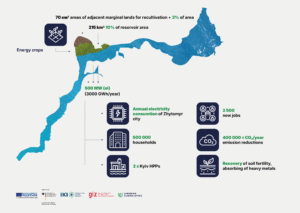The authors of the study analyzed possible recovery scenarios for the southern region of Ukraine following the destruction of the Kakhovka Hydroelectric Power Plant (KHPP). This analytical work represents the first attempt to systematise the scattered materials, research, expeditions, and expert opinions developed by various expert groups over the past 20 months. The authors set out to answer the question of what a sustainable recovery scenario should look like in terms of the “triangle” of critical needs: maximum benefit for local communities, minimisation of environmental damage, and meeting pre-disaster public needs (in terms of energy, water, access to resources, etc.).
For this, five main restoration scenarios were considered: restoration of the KHPP, natural restoration, introduction of technical hydraulic structures and mini-hydroelectric power plants, introduction of SPPs/WPPs in certain areas of the reservoir bottom, and, lastly, the introduction of energy crops on unproductive and contaminated lands at the reservoir bottom and adjacent areas for revegetation.

During the work, which also included consultations and direct participation by the expert community in Ukraine (such as power and hydropower engineers, ecologists, hydrologists, climatologists, renewable energy and energy crops specialists), various aspects of restoration for each scenario were analysed and compared in detail. This was based on a defined set of criteria: initial investment, complexity and timing of the project cycle, final energy cost, direct damage to the local ecosystem, impact on navigation, water supply and hydrology, reduction in CO₂ emissions, financing capacity, lifecycle characteristics, and timing.

The preliminary results show that the most favourable scenario involves the introduction of energy crops of various types (with a predominance of woody crops) on the unproductive and contaminated lands of the reservoir bottom, in some areas covering up to 10–20% of the territory. This depends on the layout, type of energy crops, rotation cycle, and the extent of use of areas adjacent to the reservoir. This scenario provides about twice as much energy as the original KHPP, while avoiding the flooding of large areas. Additionally, it promotes land revegetation, absorption of inorganic pollutants and heavy metals from the bottom soil and is the most similar to the natural ecosystem currently being formed in the region at the reservoir site.
Experience from the past 20 years from dozens of practical (industrial) cases of energy plantations in Ukraine and the EU suggests that, if necessary, the areas that were under energy crops and cleared of contamination can be used for other purposes later on. This scenario is the most versatile of all the ones considered. It can be implemented without being tied exclusively to the reservoir bottom area. Moreover, it can be applied in a combined configuration, with partial use of the adjacent contaminated marginal lands for revegetation. It may also serve as a basic component for the implementation of a potential energy cluster in the region, involving large point energy consumers. These would generate raw materials for the production of various energy products, ranging from electricity and heat to renewable synthetic gases, liquid biofuels, and commercial CO₂ derived from renewable energy sources.
The full version of the study is available at the link.
The study was prepared within the “Capacities for Climate Action” project implemented by GIZ on behalf of the German Federal Ministry for Economic Affairs and Climate Protection (BMWK) with the framework of the International Climate Initiative (IKI) and co-financed by the European Union.
